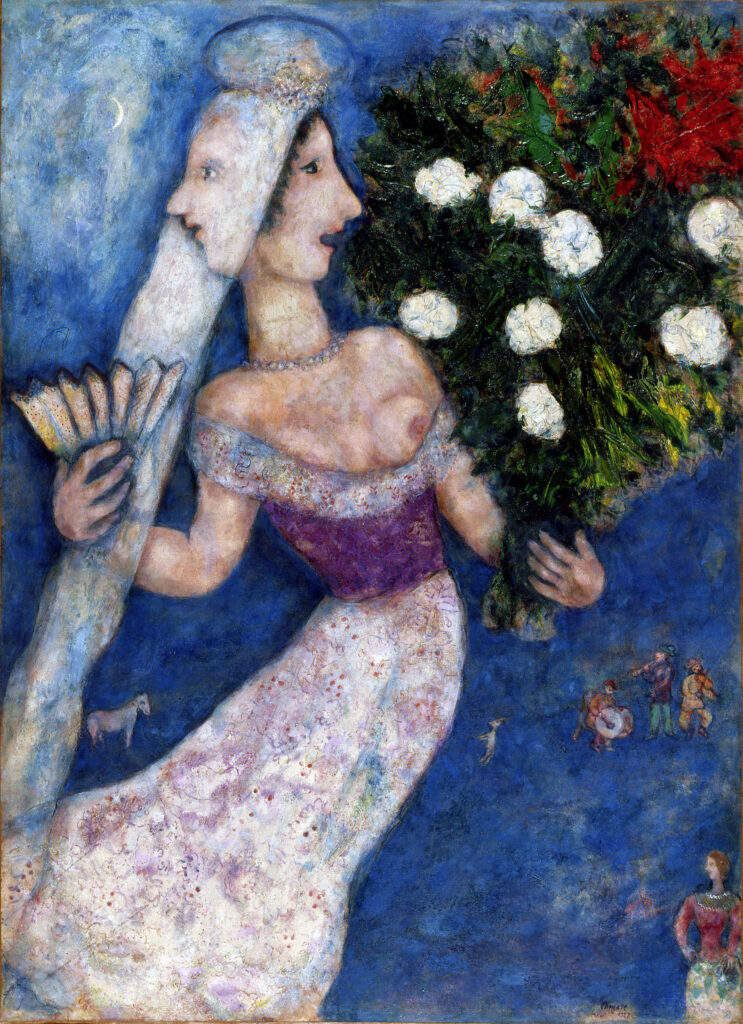From 11 October 2025 to 8 February 2026, Chagall: Witness of His Time will offer visitors an immersive journey into the artist’s poetic and visionary world. Through a rich and emotionally powerful display, the exhibition explores the key themes that shaped Chagall’s life and work.
This remarkable journey reveals how Marc Chagall (Vitebsk, 1887 – Saint-Paul de Vence, 1985) – renowned worldwide for his floating figures and dreamlike, vividly coloured compositions – preserved the memory of his homeland, its traditions, and the people and places he held dear, while continuously projecting them toward new expressive horizons.
Through 200 works, including paintings, drawings, and engravings, and two immersive rooms presenting some of Chagall’s monumental creations within a captivating, multisensory setting, the exhibition reveals the profound humanity at the core of his art. A multifaceted figure, Chagall was both a visionary and a witness of his time, a poet of beauty and a custodian of memory. Fragmented faces, multiplying profiles, mirrored portraits: through the recurring theme of the double, he reveals his extraordinary ability to capture the duality of human existence. Flying lovers, talking animals, and explosive bouquets transcend the visible world to become universal metaphors. Through his poetic gaze, Chagall transforms personal experience into shared reflection, showing how beneath the apparent simplicity of his creations lie themes that resonate deeply: identity, exile, spirituality, and the joy of life.
In an age marked by fragmentation, Chagall reminds us that art can serve as a bridge between distant worlds, a synthesis of seemingly irreconcilable traditions and a faithful reflection of humanity’s deepest aspirations and contradictions. His work celebrates an emotional truth that gives form to the most intimate dimensions of the soul, lifting it toward a beauty capable of revealing, even amid the darkest moments of history, glimmers of peace and understanding.
Exhibition organized by Fondazione Ferrara Arte and Arthemisia
Curated by Paul Schneiter and Francesca Villanti
Marc Chagall, La sposa dai due volti, 1927. Collezione privata. © Chagall ®, by SIAE 2025
HECKEll
Neue Galerie New York is pleased to announce an important monographic exhibition on the German Expressionist artist Erich Heckel (1883-1970), opening October 9, 2025. This presentation will include nearly 40 works ranging in date from 1905 to 1920, from his student years through his experience behind the frontlines as a medical orderly during World War I. The show, on view through January 12, 2026, highlights major works in the museum’s collection alongside notable loans from the Harvard Art Museums, the Metropolitan Museum of Art, the Museum of Modern Art, and the Virginia Museum of Fine Arts in Richmond, among others.
The first presentation of Heckel’s work in the United States was held in New York just over a century ago in 1923 at the Anderson Galleries. At the time, German American art historian and curator, William R. Valentiner, described Heckel’s nature as “tender and lyrical” while praising his “romantic imagination” and the “other-worldly beauty” of his landscapes. Although he had trained as an architect at Dresden’s Technische Hochschule (Technical College), Heckel proved to be a strong and expressive painter and was equally innovative as a printmaker. This exhibition celebrates his accomplishments in both fields and confirms his talent as a figurative and landscape artist.
Heckel was a founding member of the Brücke (Bridge) Artists’ Group established in Dresden in June 1905 and he played a key role in the group’s success. As chief organizer of their exhibitions from 1905 he was instrumental in the Brücke’s first museum show in 1907 held at the Folkwang Museum in 1907, and he remained a vital figure in the group until it disbanded in 1913.
The raucous colors and loose and expressive brushstrokes that defined his earliest works with the Brücke, especially his bucolic outdoor scenes, such as the ebullient Bathers in a Pond (1909), and his intimate studio scenes like the early self-portrait entitled Seated Man (1909), are replaced by a darker palette and spikey brushstrokes after Heckel moved to Berlin in December 1911 to join his other Brücke colleagues. The most significant work in the exhibition is the triptych, To the Convalescent Woman (1912-13), which centers on his future wife, the dancer Siddi Riha. The couple met in December 1910, and she became his muse, modeling for many of his paintings, drawings, prints, and sculptures. Siddi is featured in several other works in the show, including the 1913 canvas Siblings, where she is shown alongside her younger brother. Both paintings are recognized as masterpieces of the late Brücke style.
Another special aspect of the presentation will be a fulsome display of Heckel’s prints. Woodcut in particular reached a pinnacle in the early sixteenth century when German artists such as Albrecht Dürer and Lucas Cranach made their mark; Brücke artists revitalized the technique and made noteworthy contributions to modernism through their efforts in printmaking, which helped to disseminate their radical style. Heckel remained dedicated to pursuing printmaking throughout his long career, and he made groundbreaking strides in his search for a new and unpolished pictorial language. Some of his woodcuts were printed in extremely limited quantities. This show offers the chance to view these rare items alongside paintings and drawings by the artist to better appreciate the crucial dialogue that exists between these media.
A fully illustrated catalogue, published by Neue Galerie New York and Prestel, accompanies the exhibition. The texts presented in this lavishly illustrated monograph focus on Heckel’s early career and cover topics ranging from his involvement with Die Brücke; the works he created during his idyllic summers in the Friesian beach resort of Dangast; his military service during World War I; and his bold and expressive woodcuts. Emphasis is placed on his portrait and landscape paintings and his vibrant pictures of bathers, which merge both genres.
Erich Heckel
(1883-1970)
To the Convalescent Woman, 1912-13
Oil on canvas
Harvard Art Museums/Busch-Reisinger Museum
Emdmée Busch Greenough Fund
© 2025 Artists Rights Society (ARS), New York / VG Bild-Kunst, Germany

